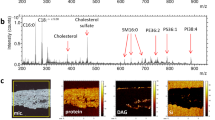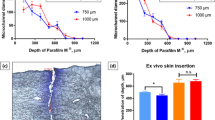ABSTRACT
Purpose
In order to increase the efficacy of a topically applied antimicrobial compound the permeation profile, localisation and mechanism of action within the skin must first be investigated.
Methods
Time-of-flight secondary ion mass spectrometry (ToF-SIMS) was used to visualise the distribution of a conventional antimicrobial compound, chlorhexidine digluconate, within porcine skin without the need for laborious preparation, radio-labels or fluorescent tags.
Results
High mass resolution and high spatial resolution mass spectra and chemical images were achieved when analysing chlorhexidine digluconate treated cryo-sectioned porcine skin sections by ToF-SIMS. The distribution of chlorhexidine digluconate was mapped throughout the skin sections and our studies indicate that the compound appears to be localised within the stratum corneum. In parallel, tape strips taken from chlorhexidine digluconate treated porcine skin were analysed by ToF-SIMS to support the distribution profile obtained from the skin sections.
Conclusions
ToF-SIMS can act as a powerful complementary technique to map the distribution of topically applied compounds within the skin.






Similar content being viewed by others
References
Eady E, Cove J. Staphylococcal resistance revisited: community-acquired methicillin resistant Staphylococcus aureus—an emerging problem for the management of skin and soft tissue infections. Curr Opin Infect Dis. 2003;16(2):103–24.
Great Britain. Health Protection Agency, Quaterly epidermiological commentary: mandatory MRSA, MSSA, E. coli bacteraemia and C. difficile infection data (up to October–December 2011). London, UK; 2003.
Roth R, James W. Microbial ecology of the skin. Annu Rev Microbiol. 1988;42:441–64.
Grice EA, Kong HH, Renaud G, Young AC, Bouffard GG, Blakesley RW, et al. A diversity profile of the human skin microbiota. Genome Res. 2008;18(7):1043–50.
Selwyn S, Ellis H. Skin bacteria and skin disinfection reconsidered. Br Med J. 1972;1(5793):136.
Paulson SD. Handbook of topical antimicrobials: Industrial applications in consumer products. London: CRC press; 2003.
Malcolm SA, Hughes TC. Demonstration of bacteria on and within the stratum corneum using scanning electron-microscopy. Br J Dermatol. 1980;102(3):267–75.
Hendley JO, Ashe KM. Eradication of resident bacteria of normal human skin by antimicrobial ointment. Antimicrob Agents Chemother. 2003;47(6):1988.
Karpanen TJ, Worthington T, Conway BR, Hilton AC, Elliott TSJ, Lambert PA. Penetration of chlorhexidine into human skin. Antimicrob Agents Chemother. 2008;52(10):3633–6.
Williams AC. Transdermal and topical drug delivery from theory to clinical practice. London: Pharmaceutical Press; 2003.
Denton WG. Chlorhexidine. In: Block SS, editor. Sterilisation and preservation. 5th ed. London: Lippincott Williams and Wilkins; 1991. p. 274–89.
Davies D, Ward R, Heylings J. Multi-species assessment of electrical resistance as a skin integrity marker for in vitro percutaneous absorption studies. Toxicol In Vitro. 2004;18(3):351–8.
Milstone AM, Passaretti CL, Perl TM. Chlorhexidine: expanding the armamentarium for infection control and prevention. Clin Infect Dis. 2008;46(2):274–81.
Lafforgue C, Carret L, Falson F, Reverdy M, Freney J. Percutaneous absorption of a chlorhexidine digluconate solution. Int J Pharm. 1997;147(2):243–6.
Smith J, Irwin W. Ionisation and the effect of absorption enhancers on transport of salicylic acid through silastic rubber and human skin. Int J Pharm. 2000;210(1–2):69–82.
Bos JD, Meinardi MMHM. The 500 Dalton rule for the skin penetration of chemical compounds and drugs. Exp Dermatol. 2000;9(3):165–9.
Farkas E, Kiss D, Zelko R. Study on the release of chlorhexidine base and salts from different liquid crystalline structures. Int J Pharm. 2007;340(1–2):71–5.
N’Dri-Stempfer B, Navidi WC, Guy RH, Bunge AL. Improved bioequivalence assessment of topical dermatological drug products using dermatopharmacokinetics. Pharm Res. 2009 Feb 2009;26(2):316–28.
Alberti I, Kalia YN, Naik A, Guy RH. Assessment and prediction of the cutaneous bioavailability of topical terbinafine, in vivo, in man. Pharm Res. 2001;18(10):1472–5.
Marttin E, Neelissen Subnel MTA, De Haan FHN, Bodde HE. A critical comparison of methods to quantify stratum corneum removed by tape stripping. Ski Pharmacol. 1996;9(1):69–77.
van der Molen RG, Spies F, vant Noordende JM, Boelsma E, Mommaas AM, Koerten HK. Tape stripping of human stratum corneum yields cell layers that originate from various depths because of furrows in the skin. Arch Dermatol Res. 1997;289(9):514–8.
Higo N, Naik A, Bommannan DB, Potts RO, Guy RH. Validation of reflectance infrared-spectroscopy as a quantitative method to measure percutaneous-absorption in-vivo. Pharm Res. 1993 Oct 1993;10(10):1500–6.
Dreher F, Modjtahedi BS, Modjtahedi SP, Maibach HI. Quantification of stratum corneum removal by adhesive tape stripping by total protein assay in 96-well microplates. Skin Res Technol. 2005 May 2005;11(2):97–101.
Lindemann U, Wilken K, Weigmann HJ, Schaefer H, Sterry W, Lademann J. Quantification of the horny layer using tape stripping and microscopic techniques. J Biomed Opt. 2003 Oct 2003;8(4):601–7.
Weigmann HJ, Lindemann U, Antoniou C, Tsikrikas GN, Stratigos AI, Katsambas A, et al. UV/VIS absorbance allows rapid, accurate, and reproducible mass determination of corneocytes removed by tape stripping. Skin Pharmacol Appl Skin Physiol. 2003 Jul–Aug 2003;16(4):217–27.
Voegeli R, Heiland J, Doppler S, Rawlings AV, Schreier T. Efficient and simple quantification of stratum corneum proteins on tape strippings by infrared densitometry. Skin Res Technol 2007 Aug 2007;13(3):242–51.
Alvarez-Roman R, Naik A, Kalia YN, Fessi H, Guy RH. Visualization of skin penetration using confocal laser scanning microscopy. Eur J Pharm Biopharm. 2004;58(2):301–16.
Mendelsohn R, Flach CR, Moore DJ. Determination of molecular conformation and permeation in skin via IR spectroscopy, microscopy, and imaging. Biochim Biophys Acta Biomembr. 2006;1758(7):923–33.
Zhang G, Moore DJ, Sloan KB, Flach CR, Mendelsohn R. Imaging the prodrug-to-drug transformation of a 5-fluorouracil derivative in skin by confocal Raman microscopy. J Invest Dermatol. 2007;127(5):1205–9.
Saar BG, Contreras-Rojas LR, Xie XS, Guy RH. Imaging drug delivery to skin with stimulated raman scattering microscopy. Mol Pharm. 2011 May–Jun 2011;8(3):969–75.
Freudiger CW, Min W, Saar BG, Lu S, Holtom GR, He C, et al. Label-free biomedical imaging with high sensitivity by stimulated raman scattering microscopy. Science. 2008;322:590–9.
Lademann J, Meinke MC, Schanzer S, Richter H, Darvin ME, Haag SF, et al. In vivo methods for the analysis of the penetration of topically applied substances in and through the skin barrier. Int J Cosmetic Sci. 2012;34(6):551–9.
Bunch J, Clench MR, Richards DS. Determination of pharmaceutical compounds in skin by imaging matrix-assisted laser desorption/ionisation mass spectrometry. Rapid Commun Mass Spectrom. 2004;18(24):3051–60.
Walch A, Rauser S, Deininger SO, Höfler H. MALDI imaging mass spectrometry for direct tissue analysis: a new frontier for molecular histology. Histochem Cell Biol. 2008;130(3):421–34.
Chaurand P, Norris JL, Cornett DS, Mobley JA, Caprioli RM. New developments in profiling and imaging of proteins from tissue sections by MALDI mass spectrometry. J Proteome Res. 2006;5(11):2889–900.
Lagarrigue M, Becker M, Lavigne R, Deininger SO, Walch A, Aubry F, et al. Revisiting rat spermatogenesis with MALDI imaging at 20-μm resolution. Mol Cell Proteomics. 2011 doi:10.1074/mcp.M110.005991.
Chabala JM, Soni KK, Li J, Gavrilov KL, Levisetti R. High-resolution chemical imaging with scanning ion probe sims. Int J Mass Spectrom Ion Process. 1995;143:191–212.
Okamoto M, Tanji N, Katayama Y, Okada J. TOF-SIMS investigation of the distribution of a cosmetic ingredient in the epidermis of the skin. Appl Surf Sci. 2006;252(19):6805–8.
Tanji N, Okamoto M, Katayama Y, Hosokawa M, Takahata N, Sano Y. Investigation of the cosmetic ingredient distribution in the stratum corneum using NanoSIMS imaging. Appl Surf Sci. 2008;255(4):1116–8.
Lee TG, Park J, Shon HK, Moon DW, Choi WW, Li K, et al. Biochemical imaging of tissues by SIMS for biomedical applications. Appl Surf Sci. 2008;255(4):1241–8.
SCCS, The Scientific Committee on Consumer Safety. Basic criteria for the in vitro assessment of dermal absorption of cosmetic ingredients. Updated, 2010; SCCS/1358/10.
Davies GE, Francis J, Martin AR, Rose FL, Swain G. 1:6-Di-4′-chlorophenyldiguanidohexane (hibitane); laboratory investigation of a new antibacterial agent of high potency. Br J Pharmacol Chemother. 1954;9(2):192–6.
Trebilcock KL, Heylings JR, Wilks MF. In-vitro tape stripping as a model for in-vivo skin stripping. Toxicol Vitr. 1994;8(4):665–7.
Aki H, Kawasaki Y. Thermodynamic clarification of interaction between antiseptic compounds and lipids consisting of stratum corneum. Thermochim Acta. 2004;416(1–2):113–9.
Elias PM. Stratum corneum defensive functions: an integrated view. J Invest Dermatol. 2005;125(2):183–200.
Lampe M, Burlingame A, Whitney J, Williams M, Brown B, Roitman E, et al. Human stratum corneum lipids: characterization and regional variations. J Lipid Res. 1983;24(2):120.
Reinertson PR, Wheatley VR. Studies on the chemical composition of human epidermal lipids. J Invest Dermatol. 1959;32:49–59.
Judd A, Scurr DJ, Heylings J, Wan KW, Griffiths D, Moss PG. Visualization of the permeation of chlorhexidine within the skin using Time-of-Flight Secondary Ion Mass Spectrometry (ToF-SIMS). In: Chilcott R, Brain KR, editors. Advances in dermatological science. London: Royal Society of Chemistry; 2013. In Press.
Brown E, Wenzel RP, Hendley JO. Exploration of the microbial anatomy of normal human skin by using plasmid profiles of coagulase-negative staphylococci: search for the reservoir of resident skin flora [with discussion]. J Infect Dis. 1989;160(4):644–50.
Touitou E, Meidan VM, Horwitz E. Methods for quantitative determination of drug localized in the skin. J Control Release. 1998;56(1–3):7–21.
ACKNOWLEDGMENTS AND DISCLOSURES
This work was funded by an EPSRC industrial CASE award in collaboration with Dermal Technology Laboratory Ltd. The authors would like to acknowledge Professor Steve Chapman for his assistance and David Griffiths for his help and advice with the skin cryo-sectioning and histology. The authors state no conflict of interest.
Author information
Authors and Affiliations
Corresponding author
Electronic supplementary material
Below is the link to the electronic supplementary material.
Figure 7
ToF-SIMS images taken in burst alignment mode of the total ion content liberated from the skin sample of 2% CHG (w/v) dosed porcine dermatomed skin (400 μm thick). The blue square demonstrates which region of the stratum corneum was magnified to enhance the visualisation of the ion distribution. MC = maximum ion count per pixel and TC = total ion count for the specific ion of interest. (DOC 160 kb)
Rights and permissions
About this article
Cite this article
Judd, A.M., Scurr, D.J., Heylings, J.R. et al. Distribution and Visualisation of Chlorhexidine Within the Skin Using ToF-SIMS: A Potential Platform for the Design of More Efficacious Skin Antiseptic Formulations. Pharm Res 30, 1896–1905 (2013). https://doi.org/10.1007/s11095-013-1032-5
Received:
Accepted:
Published:
Issue Date:
DOI: https://doi.org/10.1007/s11095-013-1032-5




